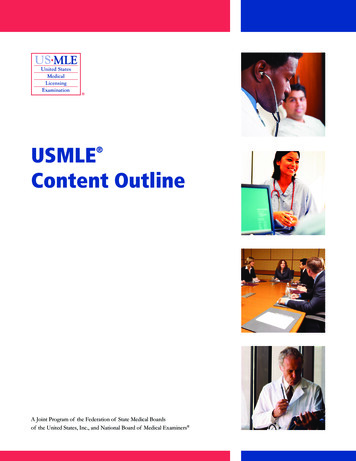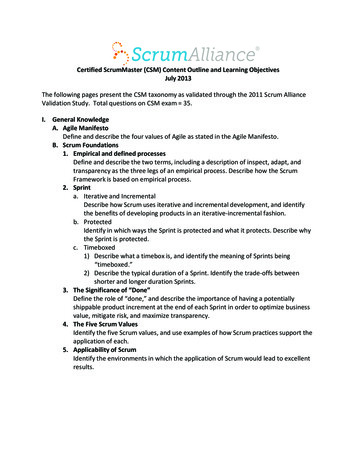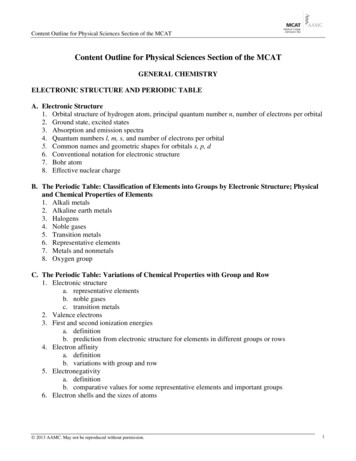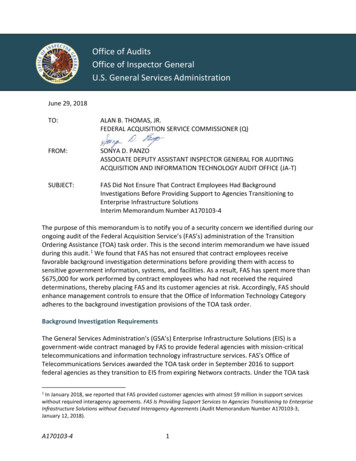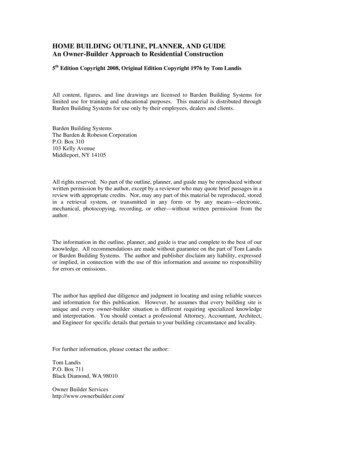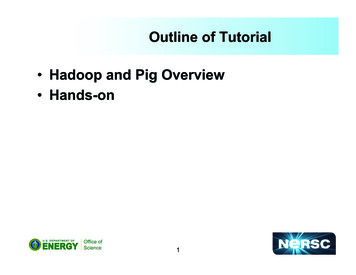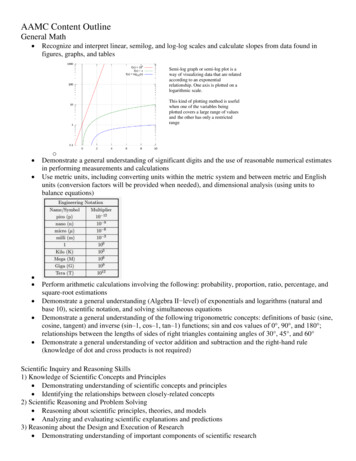
Transcription
AAMC Content OutlineGeneral Math Recognize and interpret linear, semilog, and log-log scales and calculate slopes from data found infigures, graphs, and tablesSemi-log graph or semi-log plot is away of visualizing data that are relatedaccording to an exponentialrelationship. One axis is plotted on alogarithmic scale.This kind of plotting method is usefulwhen one of the variables beingplotted covers a large range of valuesand the other has only a restrictedrange oDemonstrate a general understanding of significant digits and the use of reasonable numerical estimatesin performing measurements and calculationsUse metric units, including converting units within the metric system and between metric and Englishunits (conversion factors will be provided when needed), and dimensional analysis (using units tobalance equations)Perform arithmetic calculations involving the following: probability, proportion, ratio, percentage, andsquare-root estimationsDemonstrate a general understanding (Algebra II level) of exponentials and logarithms (natural andbase 10), scientific notation, and solving simultaneous equationsDemonstrate a general understanding of the following trigonometric concepts: definitions of basic (sine,cosine, tangent) and inverse (sin‒1, cos‒1, tan‒1) functions; sin and cos values of 0 , 90 , and 180 ;relationships between the lengths of sides of right triangles containing angles of 30 , 45 , and 60 Demonstrate a general understanding of vector addition and subtraction and the right-hand rule(knowledge of dot and cross products is not required)Scientific Inquiry and Reasoning Skills1) Knowledge of Scientific Concepts and Principles Demonstrating understanding of scientific concepts and principles Identifying the relationships between closely-related concepts2) Scientific Reasoning and Problem Solving Reasoning about scientific principles, theories, and models Analyzing and evaluating scientific explanations and predictions3) Reasoning about the Design and Execution of Research Demonstrating understanding of important components of scientific research
Reasoning about ethical issues in research4) Data-Based and Statistical Reasoning Interpreting patterns in data presented in tables, figures, and graphs Reasoning about data and drawing conclusions from themBiological and Biochemical Foundations of Living Systems“This section tests processes that are unique to living organisms, such as growing and reproducing,maintaining a constant internal environment, acquiring materials and energy, sensing and responding toenvironmental changes, and adapting. It also tests how cells and organ systems within an organism actindependently and in concert to accomplish these processes, and it asks you to reason about these processes atvarious levels of biological organization within a living system”Foundational Concept 1: Biomolecules have unique properties that determine how they contribute to thestructure and function of cells and how they participate in the processes necessary to maintain life.1A. Structure and function of proteins and their constituent amino acidsAmino Acids (BC, OC)
Description
Absolute configuration at the α position Amino acids are all L and have the absolute configuration of S. Cysteine is an exception: it is still L, but its absoluteconfiguration is R.Amino acids as dipolar ions Amino acid in physiological pH exists as a zwitterionStart off positive, become more negative (as pH becomes greater and they lose H ionsIsoelectronic point calculation (average of surrounding pKa’s)Classifications Acidic or basico Acidic: Aspartic and Glutamico Basic: Histidine, Lysine, and Arginine Note: At pH of 7, Histidine is neutral (it’s pKa is 6) Arginine and lysine have side chains with pH of roughly 10 Arginine has a “guanidine” group Hydrophobic or hydrophilicoHydrophobic: GAVLIM PPTReactionsSulfur linkage for cysteine and cystine Disulfide links are effectively oxidationsPeptide linkage: polypeptides and proteinsPeptide bond has slight double bond character – prevents bond from rotating freely, affects secondary structure and tertiary structureto some extent
Hydrolysis Most macromolecules of living cells are broken apart by hydrolysiso Ex: ATP hydrolysis, digestionDehydration – two molecules combine to form a larger molecule and water is formed as a byproductProtein Structure (BIO, BC, OC)Structure (1o to 4o) Primary structure – sequence of amino acidssecondary structure - -helix or -sheetso -sheets – can be parallel or antiparallelo reinforced by h-bonds between carbonyl oxygen of one amino acid and the hydrogen on the amino group ofanothero single protein usually contains both structures at various location throughoutTertiary structure-3D shape formed by curls and folds of the peptide chaino Five forces:o 1. Covalent disulfide bonds between cysteines to form the dimer cysteineo 2. electrostatic interactions (between acidic and basic)o 3. hydrogen bondso 4. van der Waalso 5. hydrophobic forceso Proline also plays a part – kinko Note: Salt bridges contain both electrostatic interactions and hydrogen bonding (both have to be charged)Quaternary structureo two or more polypeptide chainso same five forces as tertiaryConformational Stability (Denaturing and folding, hydrophobic interactions, solvation layer) Many different conformations available for any one protein, but it will generally exist in one of few possible conformationsthat have the highest stabilityThe solvation layer (or shell) describes the structured organization of a solvent (e.g. water) around a solute (e.g. a polypeptideor protein). In the case of a protein which displays hydrophobic residues on its surface, the surrounding water will orient intoa highly structured organization to optimize hydrogen bonding among water molecules (as hydrogen bonding with thepresented hydrophobic side chains is not an option). This highly ordered rearrangement has a much lower entropy and is lessfavorable than if polar side chains were present on the surface of the protein. Thus, a conformation that buries itshydrophobic residues inside the protein leads to less disruption of water's hydrogen bonding, allowing for less structure andhigher entropy, which increases the protein's conformational stability.o results in less entropic penaltyTwo types of proteins – globular and structuralo globular – more diverse, function as enzymes, hormones, membrane pumps, receptors, transport and storage,immune response, etco Structural – made from long polymers, maintain and add strength to cellular and matrix structure collagen – most abundant type of protein in the body, adding great strength to skin, tendons, ligaments, andboneSeparation techniquesIsoelectric point The isoelectric point is influenced by the anionic or cationic character of the protein's amino acid side chains at a certain pH.Separation can be performed by the movement of proteins over a pH gradient in a gel electrophoresis. Proteins at theirisoelectric point also have lower solubility and may precipitate out of solution.o The cathode (negative) is at the high pH end, while the anode (positive) is at the low pH endo Proteins moving from left to right get their protons stripped off and become more negative.
Negatively charged acidic proteins would be found towards the left, closer to lower pH’s (they have lowerisoelectric points) Positively charged basic protons will be found towards the right, closer to higher pH’s (they have higherisoelectric points.Note: the Cathode is always negative in biochemistry, and the anode is always positive (anions flow to the anode) Electrophoresis Electrophoresis focuses on separating proteins mainly by size or charge in the course of moving across an electric field,usually with a support medium (e.g. a gel). At the end of the migration, the proteins can be stained to show the location ofvarious protein samples, and conclusions can be drawn about the characteristics of the protein. For example, a small proteinwill travel farther than a larger protein, and a positively charge protein will be pulled towards the cathode (-) while anegatively charged protein will be pulled towards the anode ( )SDS-PAGE - used to analyse proteins. As a separation medium (also referred to as matrix) a polyacrylamide-based discontinuous gelis implemented in this type of electrophoresis. In addition, SDS (sodium dodecyl sulfate) is used. This anionic surfactant (detergent)covers the intrinsic charges of proteins. About 1.4 grams of SDS bind to a gram of protein,[3][4][5] corresponding to one SDSmolecule per two amino acids, so that the proteins have a constant negative charge distribution. Thus, the proteins will be separatedout by size only.Reducing SDS Page – cleaves disulfide bonds, destroys quaternary and tertiary structureNon-reducing SDS page – does not cleave disulfide bonds, destroys quaternary and tertiary structureNative Page – keeps quaternary structureNon-Enzymatic Protein Function (BIO, BC)Binding A special feature of some proteins is the capability to bind other molecules with non-covalent interactions. Protein bindingcan be characterized by its affinity and specificity for the binding target. Affinity describes how readily the protein binds itstarget, and specificity refers to the preferential binding of the target over other entities. A change in the protein'sconformation can alter affinity and specificity as seen in the control of voltage-gated ion channels in cell membranesImmune System The high degree of protein variability allows for a key feature of the adaptive (or acquired) immune system, the production ofantibodies. An antibody is a type of protein that has a unique and very specific binding site that will readily bind its target,called an antigen, such that its target is inactivated or tagged for immune response.Motors A motor protein can perform mechanical work by coupling exergonic (energy releasing) ATP hydrolysis to a conformationalchange that allows for interaction with the protein's target substrate. Muscle contraction, for example, is achieved through aprocess of the motor protein myosin binding and releasing its microfilament (actin) substrate. Myosin also acts onmicrofilaments of the cytoskeleton to generate cellular movement.Two other types of motor proteins, kinesins and dyneins, act on microtubules and play a role in transport within the cell.Kinesin walks microtubule "tracks" to deliver cellular cargo (e.g. chromosomes during mitosis, vesicles), generally in anantegrade direction (center to periphery). Dynein is used in retrograde cargo transport in the axons of neurons, and iscapable of sliding microtubules in relation to one another, generating the movement of cilia and flagella.Enzyme Structure and Function (BIO, BC)Function of enzymes in catalyzing biological reactions An enzyme is a biological catalyst, in that it accelerates chemical reactions in a biological system. An enzyme accomplishesthis acceleration by interacting with the reactants (the enzyme's substrates) in a manner which stabilizes their transition state(‡), which in turn lowers the activation energy (Ea) of the reaction, and a lower activation energy allows for the reaction toproceed faster.Although an enzyme interacts with its substrates, it is not consumed in the reaction like a reactant. Once a reaction completes,the enzyme is again available to process new substrate. In a biological context, the reusable nature of enzymes to catalyze aparticular reaction (the enzyme's specificity) offers a mechanism of controlling reactions by directing which enzymes arepresent and active, and in what quantities.Enzyme classification by reaction type Because of their specificity, a particular enzyme will only catalyze a singular or narrow set of similar reactions, allowing forclassification by reaction type. Names for classes of enzymes are generally descriptive of the type of reaction they catalyzeand usually end in the suffix -ase .oooMajor ClassDescription of reaction activityOxidoreductases oxidation of a hydrogen (or electron) donor (loses) and reduction of the acceptor (gains)Transferasesmove a functional group from a donor molecule to an acceptor molecule Ex: protein kinases
ooooHydrolasescouple breaking a bond with hydrolytic cleavage (breaking water) Ex: proteasesLyasesbreaking a bond with elimination to form a double bond (or ring) or adding to a double bondIsomerasesalter the geometry or structure of the reactant molecule (rearrangements)Ligasescouple forming a bond (joining two molecules) with ATP hydrolysisReduction of activation energy Over the duration of a reaction, the reactants must move through a high energy transition state before becoming products.The difference between the free energy of the reactant(s) and the free energy of the transition state is called activation energy.When the activation energy required to arrive at the transition state is lower, the reaction will proceed faster. Thus, instabilizing the transition state, an enzyme reduces activation energy and increases reaction rate.Substrates and enzyme specificity Enzyme specificity describes the highly selective nature of an enzyme for a particular reaction or set of reactions. Thereactants for a specific enzyme then are narrowly defined and called its substrates.Active Site Model The active site model describes the location on the enzyme where it interacts with its substrate. The shape and local chemicalcharacteristics (functional groups) of an active site are responsible for the specificity of the enzyme. In their interactive state,the enzyme and its substrate, bound at the active site, are called the enzyme-substrate complex.Induced-fit Model The induced-fit model describes how the interaction of an enzyme and its substrate is often reliant on effects the substrate hason the enzyme as well as effects the enzyme has on the substrate. The binding of an enzyme to its substrate results in areleas
AAMC Content Outline General Math Recognize and interpret linear, semilog, and log-log scales and calculate slopes from data found in figures, graphs, and tables o Demonstrate a general understanding of significant digits and the use of reasonable numerical estimates in performing measurements and calculations Use metric units, including converting units within the metric system .


